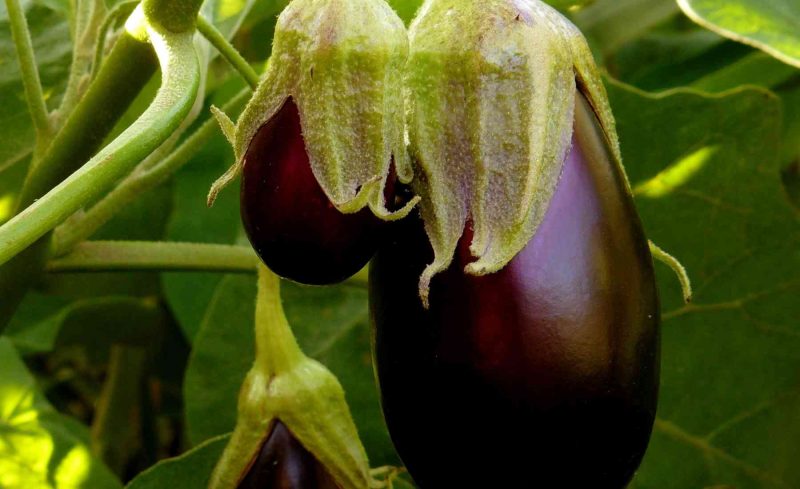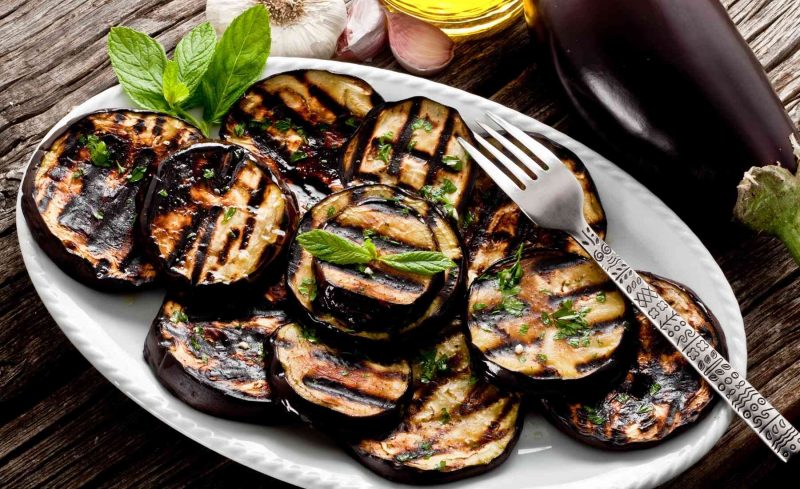There are plenty of fruits and vegetables that offer a taste that is familiar to almost everyone. A carrot is a great example of this concept. Nearly everyone you encounter – in the United States, at least – would know what a carrot tastes like and would be able to describe it in some way. Similar things can be said about other commonly used fruits and vegetables like broccoli, apples, celery, and various lettuces.
Beyond those common fruits and vegetables, there is a whole world of edible plants that serve a smaller share of the market. In this article, we are going to discuss the taste and other features of one of these – the eggplant. Plenty of people know what an eggplant tastes like, of course, but it is not used nearly as often as things like carrots and broccoli. With that said, by expanding your palette to get familiar with some of the other great items in your local produce department, you can get more enjoyment out of your food than ever before.
In this post, I’ll explain what does eggplant taste like, what an eggplant is, how to cook eggplant, how to spot a ripe eggplant, and more. Let’s get started!
What is Eggplant?
Using an accurate definition, an eggplant is a fruit, belonging to the berry family. However, it is commonly used as a vegetable in cooking applications, and it is found in many different cuisines in one form or another. Perhaps the most popular use for eggplant is in a dish known as eggplant parmesan, but you’ll find eggplant used in many different ways in many different cultures.
The precise history of the eggplant and how it came to be a domesticated crop is not known, but we do know that humans have been consuming this fruit for centuries. It has deep roots throughout a large portion of the world, including Asia and Africa.
What Does an Eggplant Look Like?
There is one distinctive trait on the eggplant that stands out above all the rest – its color. Where many plants offer up similar shades of green and brown, along with the occasional flower, the eggplant stands out from the crowd due to its vibrant purple color. The skin of the fruit is purple, and it can also have white or purple flowers. If you are walking through the produce department of your local grocery store looking for an eggplant, it is likely to be the purple color of the skin that first grabs your attention.
Beyond the distinctive color, the shape of an eggplant is notable. While their shape can vary in nature, the ones you will find at the supermarket are likely large, circular in cross-section, and fatter at the bottom than the top. If you hold an eggplant with the stem end at the top, the shape is likely to mimic a teardrop, gradually curving out at the bottom to its widest point.
Related: What Does Paprika Taste Like?
What Does Eggplant Taste Like?
So, what does eggplant taste like? The taste of eggplant, like many other fruits and vegetables, is a point of healthy debate. For some people, it’s a delicious treat when prepared correctly, and it can be the focal point of a dish. For others, the taste is not appetizing, and those in that camp will quickly move onto other options for their meals.
As a starting point, a typical eggplant will deliver a little bit of sweetness that is counteracted by some bitterness. Overall, the flavor profile is relatively mild, which brings us to perhaps the greatest strength of eggplant as an ingredient – its ability to take on other flavors. If you are looking for a natural ingredient that won’t overwhelm your dish but will instead take on the taste of whatever flavors you’d like to use, eggplant is a strong choice.
If you are looking for a comparison to another food for a taste profile, zucchini is a pretty good pick. Zucchini and eggplant don’t taste exactly the same, of course, but they are close enough in flavor and texture to make for a suitable comparison.
Related: What Do Truffles Taste Like?
Eggplant Texture
The texture you are going to get from eggplant depends entirely on what state it is in when you eat it. While it is more common to consume eggplant after it has been cooked, it is also possible to eat eggplant raw. There will be a very dramatic difference in the texture of the food between these two states.
Raw eggplant can best be described as spongy. If you were to push your finger into it a little bit, the flesh of the eggplant would bounce back when you release the pressure. This firm, spongy texture is going to come through plainly when you take a bite. Whether or not that is a good thing will depend on your perspective. Some people enjoy the taste and texture of raw eggplant, where others will only consider eating it after it has been cooked.
By contrast, cooked eggplant provides an incredibly soft, tender bite. This pleasing texture is almost certainly why eggplant is so commonly cooked instead of eaten raw – it’s simply a better experience in the minds of most people. Eggplant is arguably at its best when it is cooked along with some flavorful ingredients, as the finished dish will have a soft texture and the eggplant will have taken up the flavors that it was provided in the cooking process.
Eggplant Skin
As mentioned above, the notable component of the skin of an eggplant is the color. It is often a vibrant shade of purple, making it stand out from many of the other produce items on sale in a market. When you pick up an eggplant, you will notice the skin has a firm, smooth, rubbery feel. While the skin will usually appear to be pretty clean, it’s always a good idea to wash your fruits and vegetables thoroughly before cooking or eating.
You are free to eat the skin of the eggplant along with the flesh, if you so choose. As is the case with many plants, the skin actually holds a lot of the nutritional value, so that is one argument in favor of leaving it on. However, depending on what you are making and how you are cooking the eggplant, you might find that you prefer to take it off. In that case, a standard vegetable peeler should do the job without any trouble.
An eggplant on the larger end of the typical range will likely have a pretty thick skin, making it tough to eat and enjoy. So, if you are picking one out with the intention of eating a skin, look for a smaller one so you have a better chance of getting relatively thin skin that is easy to eat.
Eggplant Seeds
As you might expect, you will find seeds inside an eggplant when you cut one open to prepare a meal. Fortunately, you are welcome to eat the seeds if you would like, so you don’t have to go through the step of taking them out. With that said, some people don’t like the taste that eggplant seeds bring to their dishes, so removing them is always an option.
You’ll quickly spot the seeds when you cut open the eggplant, and you should be able to scoop them out with a spoon. If you don’t have any other plans for the seeds, discard that scooped out portion and proceed with the rest of your recipe, now using only the portion of the eggplant that does not contain seeds.
Of course, you don’t have to throw the seeds away. If you are an avid gardener and would like to add another species to your collection, consider planting the seeds. Clean them off after you remove them with the eggplant and store them in a safe place. Then, research instructions for planting eggplant seeds that are specific to your area and climate. If your crop is successful, you could soon be harvesting tasty eggplants from your own backyard, rather than taking a trip to the store.

How to Spot a Ripe Eggplant
There is an art to buying any kind of fruit or vegetable at the grocery store. For the fruits and veggies that you buy regularly, you probably already know how to find ones that are ripe and ready to eat. For instance, bananas that are still green aren’t quite ready to be consumed, but those that have turned brown have gone too far (and maybe better suited to baking than to eating on their own).
So, how do you know which eggplants are best when you see a bunch of them piled up in front of you? Picking the right eggplant is something you should get better at with experience, but there are a couple of handy tips you can use to get started. First, look at the skin. You want to see a smooth, shiny skin coating the outside of the eggplant. When the skin starts to wrinkle, you might be looking at an old eggplant that won’t be particularly tasty. Look all the way around the eggplant and try to find one that has shiny, smooth skin wrapped around the fruit.
Another thing to watch out for is an eggplant that feels particularly soft. You want the fruit to feel pretty firm when you press on it, so pass on the ones that have too much give. Also, an eggplant that has been sitting around the store for a while may have a brown stem, so keep an eye out for those that still have a green stem on top.
Lastly, picking the right size eggplant can help you get the best possible taste. If you need a lot of eggplant for a recipe, it’s tempting to look for the biggest one you can find – but those ones can be bitter. Look for smaller eggplants when possible and simply buy more if necessary, to have enough for your dish.

Best Methods for Cooking Eggplant
You might be wondering how to cook eggplant. With a ripe eggplant or two selected and brought back home, your next step will be to get down to cooking. On this point, you are going to have a lot of options. There is no way we can cover all of the possible ways to cook an eggplant here in this section, be we can touch on some of the most popular approaches. Test various preparations out for yourself to determine which you like best.
Grilling
You might think first about proteins like steak or chicken when firing up the grill, but eggplant takes to this cooking method surprisingly well. Since it is so firm when raw, you can toss slices onto the grates of your grill without any trouble. Rubbing a little oil on both sides of the flesh before grilling should help minimize sticking. You could feature grilled eggplant as the feature of your main course, or it could make for a tasty side to go along with whatever else you prepared on the grill.
Baking
To keep things simple, just turn on the oven and bake your eggplant. Before baking, you’ll want to cut it up into smaller pieces rather than trying to bake the entire thing whole. Slices are a typical shape and leaving the skin on will help those slices hold together nicely. You could also cut your eggplant up into chunks, or even strips, and then bake them off. Plenty of recipes call for the use of baked eggplant, so this is a commonly used method of getting the flesh to that beautifully tender texture you may be after.
Sauté
For a quick preparation, just cut up some pieces of eggplant and toss it into a hot pan with a little bit of cooking oil like olive oil. In just a few minutes, the flesh of the eggplant will have softened up, and you might get some browning – which will only add to the overall flavor profile. This is a particularly appealing option when you are using eggplant as a side, since it is quick and easy to toss some in a pan and have it come out tasting great.
Frying
Frying foods is a little bit more work than some of the other methods we have suggested, and there tends to be more cleanup, but that effort could well worth it when your eggplant comes out just right. You have a couple of options here to consider, pan frying and deep frying. With pan frying, you’ll only use enough oil to come just a bit up the sides of your pan or pot. Then, you place some eggplant pieces down in the oil, let them cook for a bit, and then flip them over to finish the process. Deep frying will require more oil, as you’ll need enough for the entire piece to drop below the top of the olive oil with a little room to spare. Frying probably won’t become your go-to option for cooking eggplant every time you want to add some to a dish, but it can be a nice treat when you are in the mood to do a little extra work. One common dish is eggplant parmesan.
Final Thoughts on What an Eggplant Tastes Like
We’ve covered a lot of ground on the topic of eggplants in this article. Everything from what does eggplant taste like to its expected texture, the eggplant’s skin, and much more has been discussed above.
An eggplant is a purple fruit with a relatively tough, rubbery skin and a wide, teardrop shape. This plant is used as a food in many cultures and can be prepared in a variety of different ways. Eggplant taste can be compared to zucchini, although it brings its own distinct flavor that has to be experienced to be understood.
Eggplant skin is edible and does contain some valuable nutrition, but larger eggplants can develop a rather thick skin that you may prefer to peel off for a more pleasant eating experience. The flesh of a raw eggplant offers a rather spongy texture, and it can be eaten that way, but it is more often cooked. After cooking, the flesh becomes quite soft and tender, making it enjoyable to eat. Also, the rather mild flavor of an eggplant effectively picks up other flavors, making it a versatile ingredient to use in your kitchen.
Do you like eggplant taste?
